Report: Principles of Business Communication and Its Applications
VerifiedAdded on 2020/06/06
|10
|3008
|65
Report
AI Summary
This report provides a comprehensive overview of the principles of business communication. It begins by exploring the importance and features of negotiation, including tactics and their components. The report then delves into different types of presentations, outlining their requirements and methods of delivery, along with the use of resources and feedback collection. Furthermore, the document examines bespoke business documents, detailing their characteristics, creation factors, legal requirements, and approval processes. Finally, the report analyzes information systems development, discussing the typical stages, benefits, limitations, and legal/security considerations. The content covers a wide range of topics relevant to effective communication within a business environment, supported by references to academic sources.
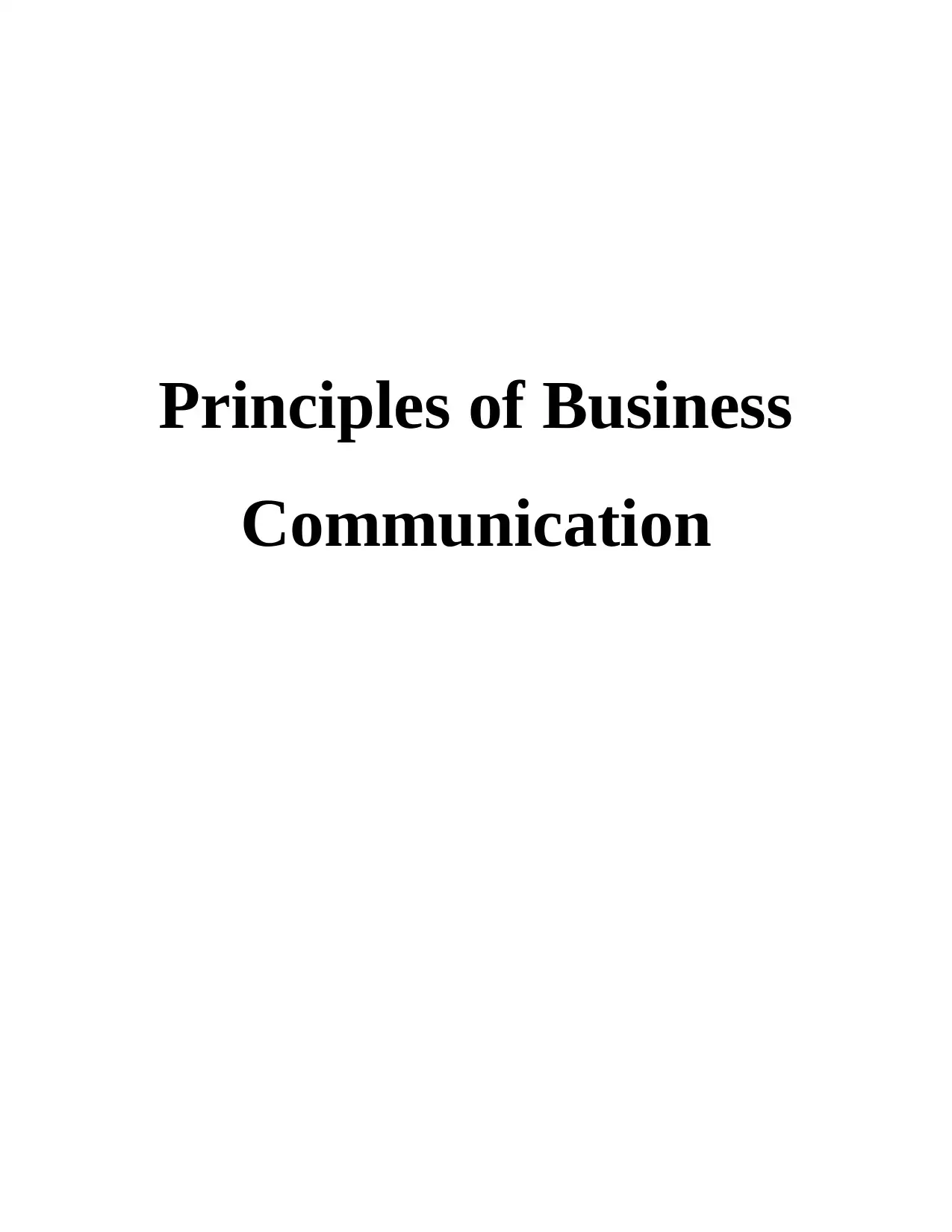
Principles of Business
Communication
Communication
Paraphrase This Document
Need a fresh take? Get an instant paraphrase of this document with our AI Paraphraser
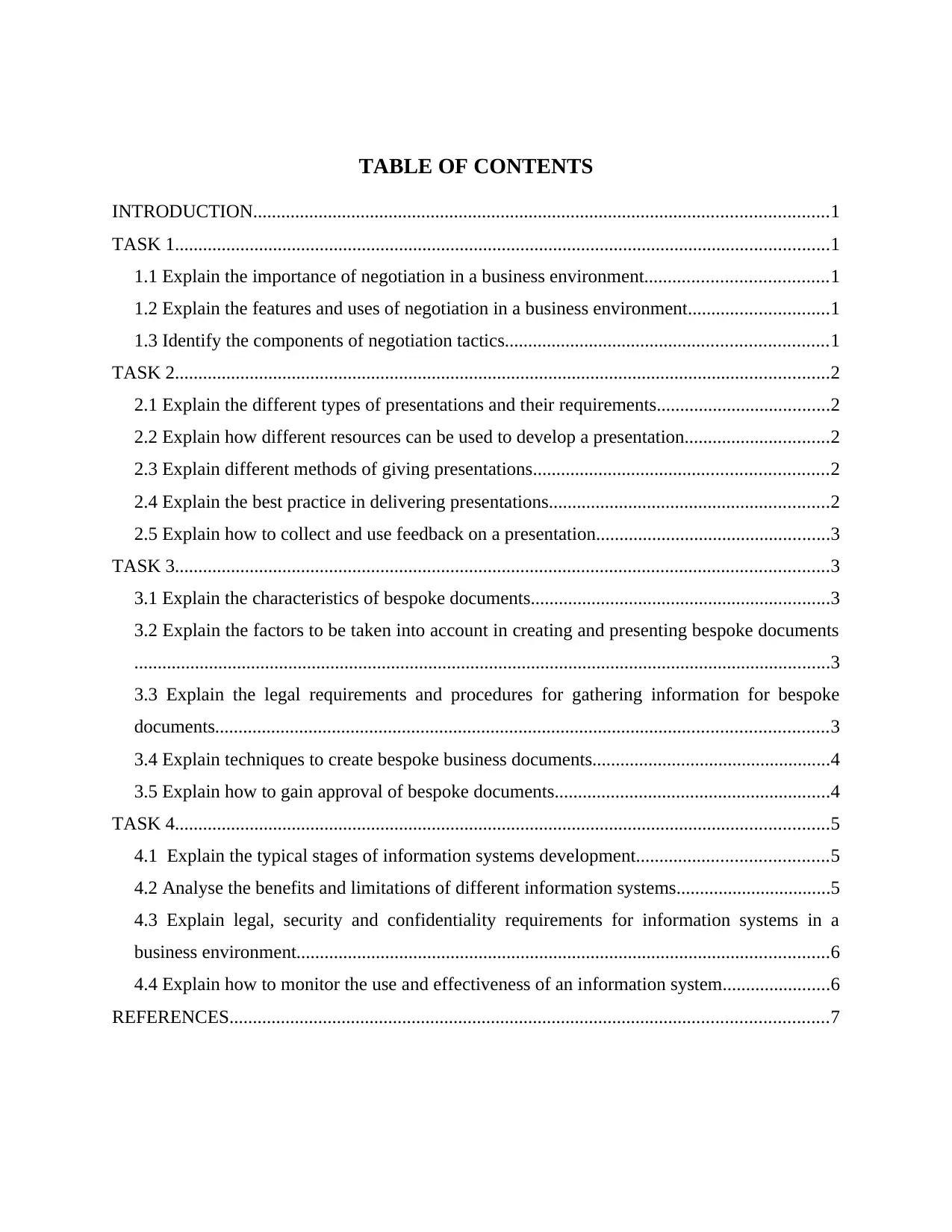
TABLE OF CONTENTS
INTRODUCTION...........................................................................................................................1
TASK 1............................................................................................................................................1
1.1 Explain the importance of negotiation in a business environment.......................................1
1.2 Explain the features and uses of negotiation in a business environment..............................1
1.3 Identify the components of negotiation tactics.....................................................................1
TASK 2............................................................................................................................................2
2.1 Explain the different types of presentations and their requirements.....................................2
2.2 Explain how different resources can be used to develop a presentation...............................2
2.3 Explain different methods of giving presentations...............................................................2
2.4 Explain the best practice in delivering presentations............................................................2
2.5 Explain how to collect and use feedback on a presentation..................................................3
TASK 3............................................................................................................................................3
3.1 Explain the characteristics of bespoke documents................................................................3
3.2 Explain the factors to be taken into account in creating and presenting bespoke documents
.....................................................................................................................................................3
3.3 Explain the legal requirements and procedures for gathering information for bespoke
documents...................................................................................................................................3
3.4 Explain techniques to create bespoke business documents...................................................4
3.5 Explain how to gain approval of bespoke documents...........................................................4
TASK 4............................................................................................................................................5
4.1 Explain the typical stages of information systems development.........................................5
4.2 Analyse the benefits and limitations of different information systems.................................5
4.3 Explain legal, security and confidentiality requirements for information systems in a
business environment..................................................................................................................6
4.4 Explain how to monitor the use and effectiveness of an information system.......................6
REFERENCES................................................................................................................................7
INTRODUCTION...........................................................................................................................1
TASK 1............................................................................................................................................1
1.1 Explain the importance of negotiation in a business environment.......................................1
1.2 Explain the features and uses of negotiation in a business environment..............................1
1.3 Identify the components of negotiation tactics.....................................................................1
TASK 2............................................................................................................................................2
2.1 Explain the different types of presentations and their requirements.....................................2
2.2 Explain how different resources can be used to develop a presentation...............................2
2.3 Explain different methods of giving presentations...............................................................2
2.4 Explain the best practice in delivering presentations............................................................2
2.5 Explain how to collect and use feedback on a presentation..................................................3
TASK 3............................................................................................................................................3
3.1 Explain the characteristics of bespoke documents................................................................3
3.2 Explain the factors to be taken into account in creating and presenting bespoke documents
.....................................................................................................................................................3
3.3 Explain the legal requirements and procedures for gathering information for bespoke
documents...................................................................................................................................3
3.4 Explain techniques to create bespoke business documents...................................................4
3.5 Explain how to gain approval of bespoke documents...........................................................4
TASK 4............................................................................................................................................5
4.1 Explain the typical stages of information systems development.........................................5
4.2 Analyse the benefits and limitations of different information systems.................................5
4.3 Explain legal, security and confidentiality requirements for information systems in a
business environment..................................................................................................................6
4.4 Explain how to monitor the use and effectiveness of an information system.......................6
REFERENCES................................................................................................................................7
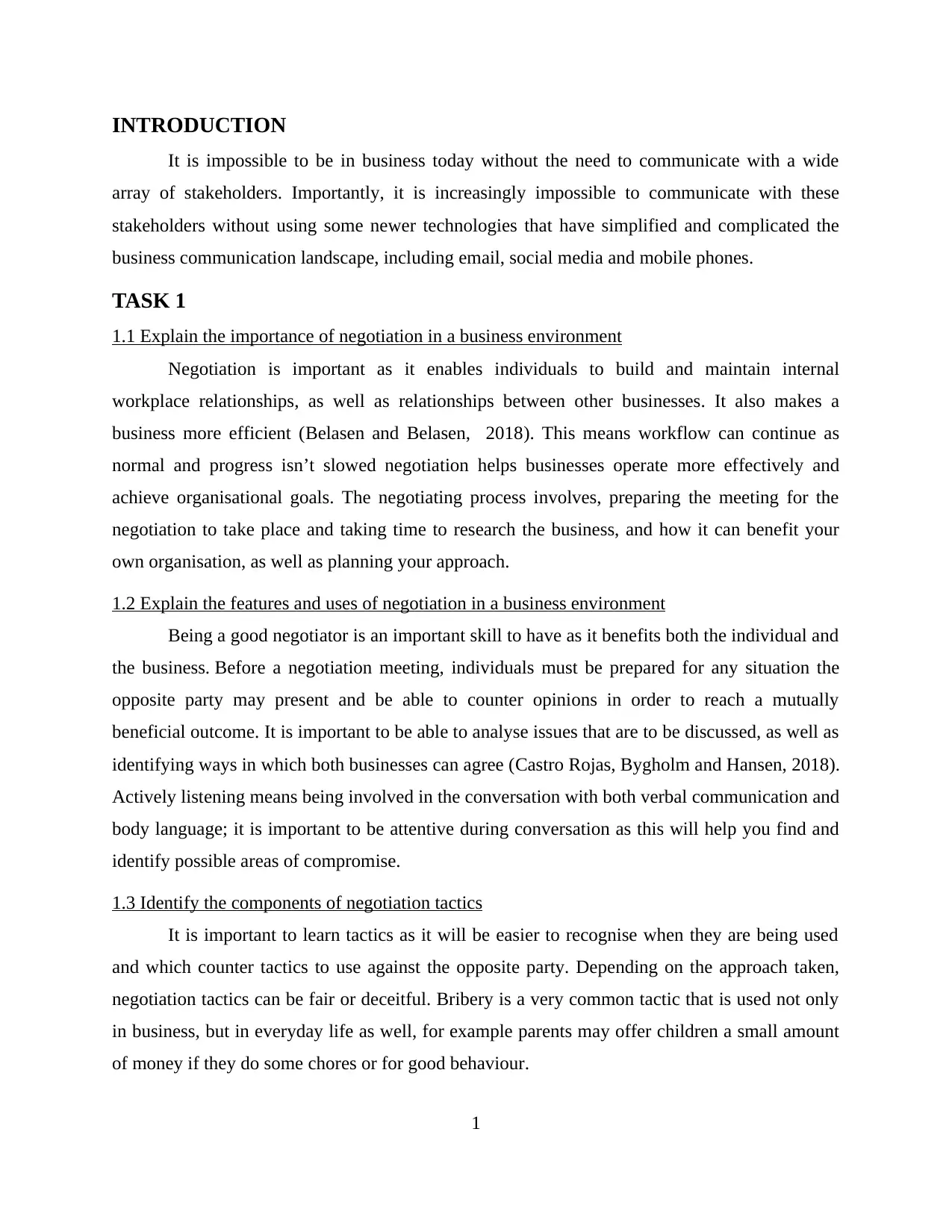
INTRODUCTION
It is impossible to be in business today without the need to communicate with a wide
array of stakeholders. Importantly, it is increasingly impossible to communicate with these
stakeholders without using some newer technologies that have simplified and complicated the
business communication landscape, including email, social media and mobile phones.
TASK 1
1.1 Explain the importance of negotiation in a business environment
Negotiation is important as it enables individuals to build and maintain internal
workplace relationships, as well as relationships between other businesses. It also makes a
business more efficient (Belasen and Belasen, 2018). This means workflow can continue as
normal and progress isn’t slowed negotiation helps businesses operate more effectively and
achieve organisational goals. The negotiating process involves, preparing the meeting for the
negotiation to take place and taking time to research the business, and how it can benefit your
own organisation, as well as planning your approach.
1.2 Explain the features and uses of negotiation in a business environment
Being a good negotiator is an important skill to have as it benefits both the individual and
the business. Before a negotiation meeting, individuals must be prepared for any situation the
opposite party may present and be able to counter opinions in order to reach a mutually
beneficial outcome. It is important to be able to analyse issues that are to be discussed, as well as
identifying ways in which both businesses can agree (Castro Rojas, Bygholm and Hansen, 2018).
Actively listening means being involved in the conversation with both verbal communication and
body language; it is important to be attentive during conversation as this will help you find and
identify possible areas of compromise.
1.3 Identify the components of negotiation tactics
It is important to learn tactics as it will be easier to recognise when they are being used
and which counter tactics to use against the opposite party. Depending on the approach taken,
negotiation tactics can be fair or deceitful. Bribery is a very common tactic that is used not only
in business, but in everyday life as well, for example parents may offer children a small amount
of money if they do some chores or for good behaviour.
1
It is impossible to be in business today without the need to communicate with a wide
array of stakeholders. Importantly, it is increasingly impossible to communicate with these
stakeholders without using some newer technologies that have simplified and complicated the
business communication landscape, including email, social media and mobile phones.
TASK 1
1.1 Explain the importance of negotiation in a business environment
Negotiation is important as it enables individuals to build and maintain internal
workplace relationships, as well as relationships between other businesses. It also makes a
business more efficient (Belasen and Belasen, 2018). This means workflow can continue as
normal and progress isn’t slowed negotiation helps businesses operate more effectively and
achieve organisational goals. The negotiating process involves, preparing the meeting for the
negotiation to take place and taking time to research the business, and how it can benefit your
own organisation, as well as planning your approach.
1.2 Explain the features and uses of negotiation in a business environment
Being a good negotiator is an important skill to have as it benefits both the individual and
the business. Before a negotiation meeting, individuals must be prepared for any situation the
opposite party may present and be able to counter opinions in order to reach a mutually
beneficial outcome. It is important to be able to analyse issues that are to be discussed, as well as
identifying ways in which both businesses can agree (Castro Rojas, Bygholm and Hansen, 2018).
Actively listening means being involved in the conversation with both verbal communication and
body language; it is important to be attentive during conversation as this will help you find and
identify possible areas of compromise.
1.3 Identify the components of negotiation tactics
It is important to learn tactics as it will be easier to recognise when they are being used
and which counter tactics to use against the opposite party. Depending on the approach taken,
negotiation tactics can be fair or deceitful. Bribery is a very common tactic that is used not only
in business, but in everyday life as well, for example parents may offer children a small amount
of money if they do some chores or for good behaviour.
1
⊘ This is a preview!⊘
Do you want full access?
Subscribe today to unlock all pages.

Trusted by 1+ million students worldwide
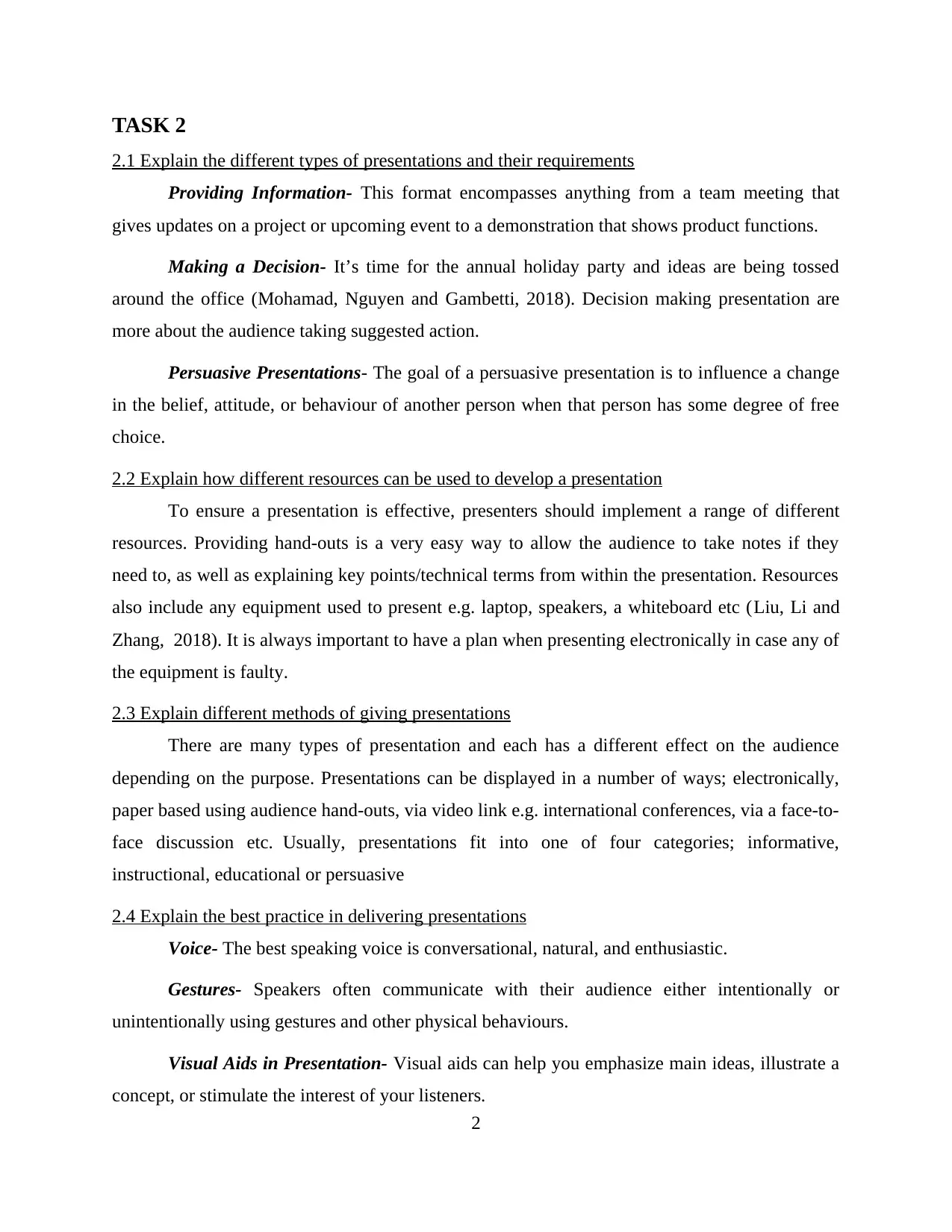
TASK 2
2.1 Explain the different types of presentations and their requirements
Providing Information- This format encompasses anything from a team meeting that
gives updates on a project or upcoming event to a demonstration that shows product functions.
Making a Decision- It’s time for the annual holiday party and ideas are being tossed
around the office (Mohamad, Nguyen and Gambetti, 2018). Decision making presentation are
more about the audience taking suggested action.
Persuasive Presentations- The goal of a persuasive presentation is to influence a change
in the belief, attitude, or behaviour of another person when that person has some degree of free
choice.
2.2 Explain how different resources can be used to develop a presentation
To ensure a presentation is effective, presenters should implement a range of different
resources. Providing hand-outs is a very easy way to allow the audience to take notes if they
need to, as well as explaining key points/technical terms from within the presentation. Resources
also include any equipment used to present e.g. laptop, speakers, a whiteboard etc (Liu, Li and
Zhang, 2018). It is always important to have a plan when presenting electronically in case any of
the equipment is faulty.
2.3 Explain different methods of giving presentations
There are many types of presentation and each has a different effect on the audience
depending on the purpose. Presentations can be displayed in a number of ways; electronically,
paper based using audience hand-outs, via video link e.g. international conferences, via a face-to-
face discussion etc. Usually, presentations fit into one of four categories; informative,
instructional, educational or persuasive
2.4 Explain the best practice in delivering presentations
Voice- The best speaking voice is conversational, natural, and enthusiastic.
Gestures- Speakers often communicate with their audience either intentionally or
unintentionally using gestures and other physical behaviours.
Visual Aids in Presentation- Visual aids can help you emphasize main ideas, illustrate a
concept, or stimulate the interest of your listeners.
2
2.1 Explain the different types of presentations and their requirements
Providing Information- This format encompasses anything from a team meeting that
gives updates on a project or upcoming event to a demonstration that shows product functions.
Making a Decision- It’s time for the annual holiday party and ideas are being tossed
around the office (Mohamad, Nguyen and Gambetti, 2018). Decision making presentation are
more about the audience taking suggested action.
Persuasive Presentations- The goal of a persuasive presentation is to influence a change
in the belief, attitude, or behaviour of another person when that person has some degree of free
choice.
2.2 Explain how different resources can be used to develop a presentation
To ensure a presentation is effective, presenters should implement a range of different
resources. Providing hand-outs is a very easy way to allow the audience to take notes if they
need to, as well as explaining key points/technical terms from within the presentation. Resources
also include any equipment used to present e.g. laptop, speakers, a whiteboard etc (Liu, Li and
Zhang, 2018). It is always important to have a plan when presenting electronically in case any of
the equipment is faulty.
2.3 Explain different methods of giving presentations
There are many types of presentation and each has a different effect on the audience
depending on the purpose. Presentations can be displayed in a number of ways; electronically,
paper based using audience hand-outs, via video link e.g. international conferences, via a face-to-
face discussion etc. Usually, presentations fit into one of four categories; informative,
instructional, educational or persuasive
2.4 Explain the best practice in delivering presentations
Voice- The best speaking voice is conversational, natural, and enthusiastic.
Gestures- Speakers often communicate with their audience either intentionally or
unintentionally using gestures and other physical behaviours.
Visual Aids in Presentation- Visual aids can help you emphasize main ideas, illustrate a
concept, or stimulate the interest of your listeners.
2
Paraphrase This Document
Need a fresh take? Get an instant paraphrase of this document with our AI Paraphraser
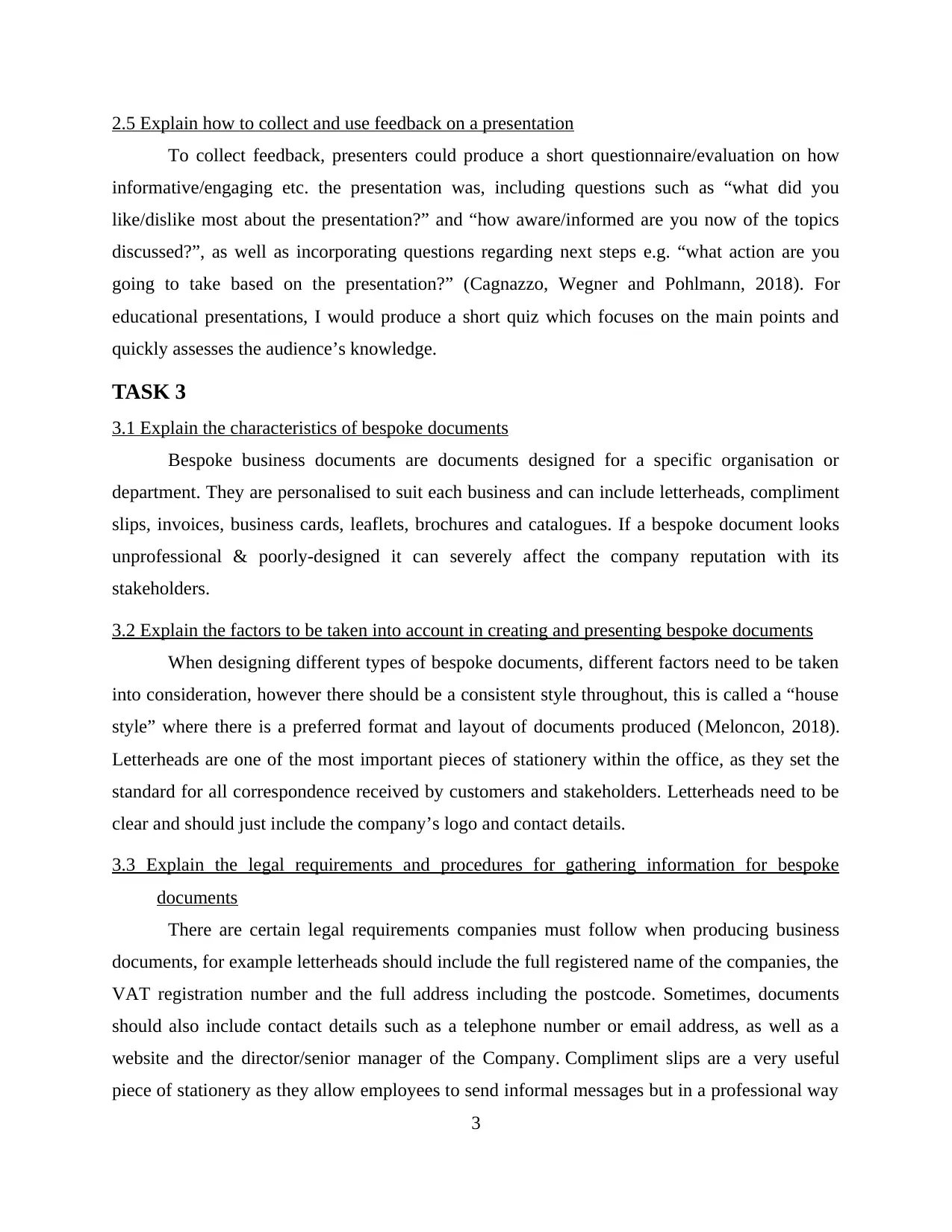
2.5 Explain how to collect and use feedback on a presentation
To collect feedback, presenters could produce a short questionnaire/evaluation on how
informative/engaging etc. the presentation was, including questions such as “what did you
like/dislike most about the presentation?” and “how aware/informed are you now of the topics
discussed?”, as well as incorporating questions regarding next steps e.g. “what action are you
going to take based on the presentation?” (Cagnazzo, Wegner and Pohlmann, 2018). For
educational presentations, I would produce a short quiz which focuses on the main points and
quickly assesses the audience’s knowledge.
TASK 3
3.1 Explain the characteristics of bespoke documents
Bespoke business documents are documents designed for a specific organisation or
department. They are personalised to suit each business and can include letterheads, compliment
slips, invoices, business cards, leaflets, brochures and catalogues. If a bespoke document looks
unprofessional & poorly-designed it can severely affect the company reputation with its
stakeholders.
3.2 Explain the factors to be taken into account in creating and presenting bespoke documents
When designing different types of bespoke documents, different factors need to be taken
into consideration, however there should be a consistent style throughout, this is called a “house
style” where there is a preferred format and layout of documents produced (Meloncon, 2018).
Letterheads are one of the most important pieces of stationery within the office, as they set the
standard for all correspondence received by customers and stakeholders. Letterheads need to be
clear and should just include the company’s logo and contact details.
3.3 Explain the legal requirements and procedures for gathering information for bespoke
documents
There are certain legal requirements companies must follow when producing business
documents, for example letterheads should include the full registered name of the companies, the
VAT registration number and the full address including the postcode. Sometimes, documents
should also include contact details such as a telephone number or email address, as well as a
website and the director/senior manager of the Company. Compliment slips are a very useful
piece of stationery as they allow employees to send informal messages but in a professional way
3
To collect feedback, presenters could produce a short questionnaire/evaluation on how
informative/engaging etc. the presentation was, including questions such as “what did you
like/dislike most about the presentation?” and “how aware/informed are you now of the topics
discussed?”, as well as incorporating questions regarding next steps e.g. “what action are you
going to take based on the presentation?” (Cagnazzo, Wegner and Pohlmann, 2018). For
educational presentations, I would produce a short quiz which focuses on the main points and
quickly assesses the audience’s knowledge.
TASK 3
3.1 Explain the characteristics of bespoke documents
Bespoke business documents are documents designed for a specific organisation or
department. They are personalised to suit each business and can include letterheads, compliment
slips, invoices, business cards, leaflets, brochures and catalogues. If a bespoke document looks
unprofessional & poorly-designed it can severely affect the company reputation with its
stakeholders.
3.2 Explain the factors to be taken into account in creating and presenting bespoke documents
When designing different types of bespoke documents, different factors need to be taken
into consideration, however there should be a consistent style throughout, this is called a “house
style” where there is a preferred format and layout of documents produced (Meloncon, 2018).
Letterheads are one of the most important pieces of stationery within the office, as they set the
standard for all correspondence received by customers and stakeholders. Letterheads need to be
clear and should just include the company’s logo and contact details.
3.3 Explain the legal requirements and procedures for gathering information for bespoke
documents
There are certain legal requirements companies must follow when producing business
documents, for example letterheads should include the full registered name of the companies, the
VAT registration number and the full address including the postcode. Sometimes, documents
should also include contact details such as a telephone number or email address, as well as a
website and the director/senior manager of the Company. Compliment slips are a very useful
piece of stationery as they allow employees to send informal messages but in a professional way
3
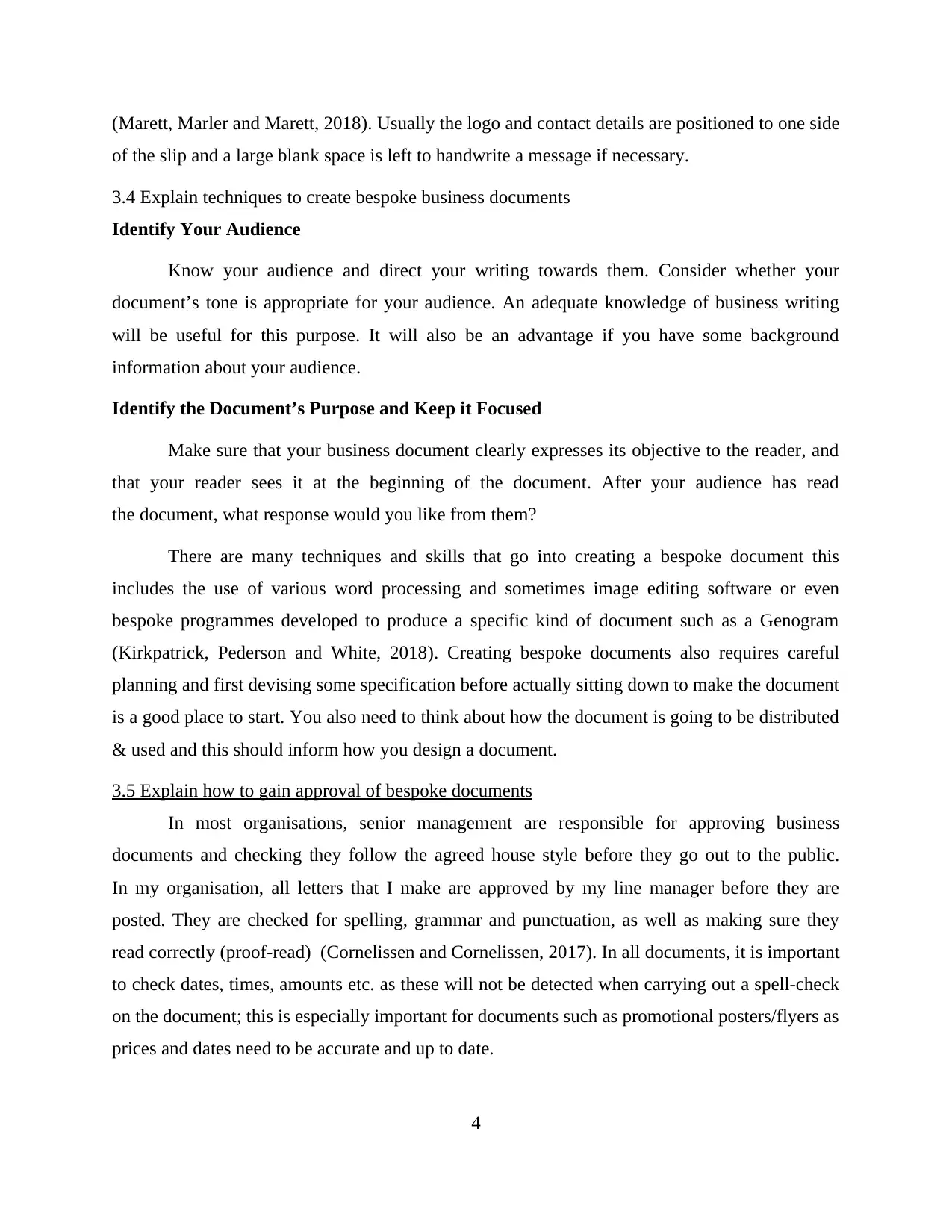
(Marett, Marler and Marett, 2018). Usually the logo and contact details are positioned to one side
of the slip and a large blank space is left to handwrite a message if necessary.
3.4 Explain techniques to create bespoke business documents
Identify Your Audience
Know your audience and direct your writing towards them. Consider whether your
document’s tone is appropriate for your audience. An adequate knowledge of business writing
will be useful for this purpose. It will also be an advantage if you have some background
information about your audience.
Identify the Document’s Purpose and Keep it Focused
Make sure that your business document clearly expresses its objective to the reader, and
that your reader sees it at the beginning of the document. After your audience has read
the document, what response would you like from them?
There are many techniques and skills that go into creating a bespoke document this
includes the use of various word processing and sometimes image editing software or even
bespoke programmes developed to produce a specific kind of document such as a Genogram
(Kirkpatrick, Pederson and White, 2018). Creating bespoke documents also requires careful
planning and first devising some specification before actually sitting down to make the document
is a good place to start. You also need to think about how the document is going to be distributed
& used and this should inform how you design a document.
3.5 Explain how to gain approval of bespoke documents
In most organisations, senior management are responsible for approving business
documents and checking they follow the agreed house style before they go out to the public.
In my organisation, all letters that I make are approved by my line manager before they are
posted. They are checked for spelling, grammar and punctuation, as well as making sure they
read correctly (proof-read) (Cornelissen and Cornelissen, 2017). In all documents, it is important
to check dates, times, amounts etc. as these will not be detected when carrying out a spell-check
on the document; this is especially important for documents such as promotional posters/flyers as
prices and dates need to be accurate and up to date.
4
of the slip and a large blank space is left to handwrite a message if necessary.
3.4 Explain techniques to create bespoke business documents
Identify Your Audience
Know your audience and direct your writing towards them. Consider whether your
document’s tone is appropriate for your audience. An adequate knowledge of business writing
will be useful for this purpose. It will also be an advantage if you have some background
information about your audience.
Identify the Document’s Purpose and Keep it Focused
Make sure that your business document clearly expresses its objective to the reader, and
that your reader sees it at the beginning of the document. After your audience has read
the document, what response would you like from them?
There are many techniques and skills that go into creating a bespoke document this
includes the use of various word processing and sometimes image editing software or even
bespoke programmes developed to produce a specific kind of document such as a Genogram
(Kirkpatrick, Pederson and White, 2018). Creating bespoke documents also requires careful
planning and first devising some specification before actually sitting down to make the document
is a good place to start. You also need to think about how the document is going to be distributed
& used and this should inform how you design a document.
3.5 Explain how to gain approval of bespoke documents
In most organisations, senior management are responsible for approving business
documents and checking they follow the agreed house style before they go out to the public.
In my organisation, all letters that I make are approved by my line manager before they are
posted. They are checked for spelling, grammar and punctuation, as well as making sure they
read correctly (proof-read) (Cornelissen and Cornelissen, 2017). In all documents, it is important
to check dates, times, amounts etc. as these will not be detected when carrying out a spell-check
on the document; this is especially important for documents such as promotional posters/flyers as
prices and dates need to be accurate and up to date.
4
⊘ This is a preview!⊘
Do you want full access?
Subscribe today to unlock all pages.

Trusted by 1+ million students worldwide
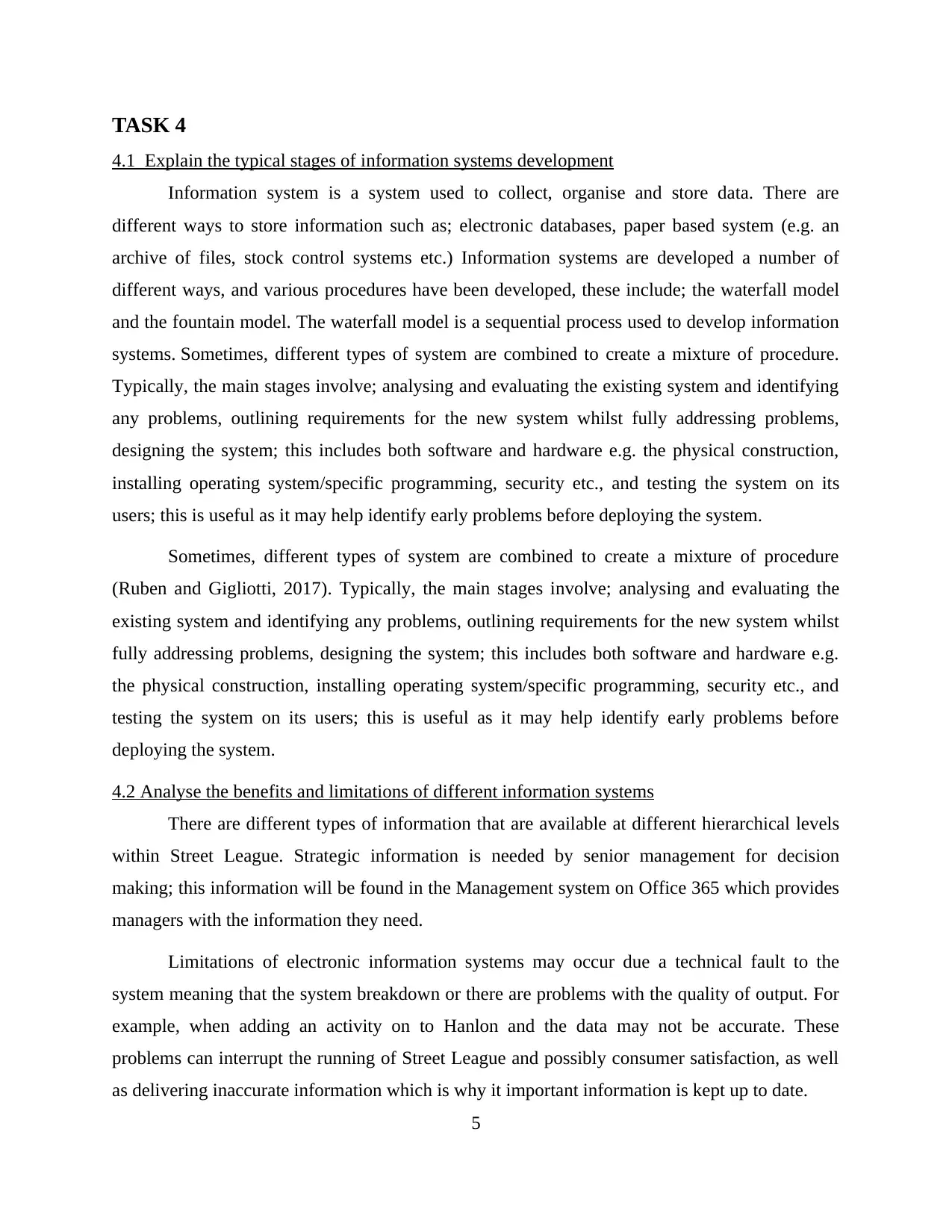
TASK 4
4.1 Explain the typical stages of information systems development
Information system is a system used to collect, organise and store data. There are
different ways to store information such as; electronic databases, paper based system (e.g. an
archive of files, stock control systems etc.) Information systems are developed a number of
different ways, and various procedures have been developed, these include; the waterfall model
and the fountain model. The waterfall model is a sequential process used to develop information
systems. Sometimes, different types of system are combined to create a mixture of procedure.
Typically, the main stages involve; analysing and evaluating the existing system and identifying
any problems, outlining requirements for the new system whilst fully addressing problems,
designing the system; this includes both software and hardware e.g. the physical construction,
installing operating system/specific programming, security etc., and testing the system on its
users; this is useful as it may help identify early problems before deploying the system.
Sometimes, different types of system are combined to create a mixture of procedure
(Ruben and Gigliotti, 2017). Typically, the main stages involve; analysing and evaluating the
existing system and identifying any problems, outlining requirements for the new system whilst
fully addressing problems, designing the system; this includes both software and hardware e.g.
the physical construction, installing operating system/specific programming, security etc., and
testing the system on its users; this is useful as it may help identify early problems before
deploying the system.
4.2 Analyse the benefits and limitations of different information systems
There are different types of information that are available at different hierarchical levels
within Street League. Strategic information is needed by senior management for decision
making; this information will be found in the Management system on Office 365 which provides
managers with the information they need.
Limitations of electronic information systems may occur due a technical fault to the
system meaning that the system breakdown or there are problems with the quality of output. For
example, when adding an activity on to Hanlon and the data may not be accurate. These
problems can interrupt the running of Street League and possibly consumer satisfaction, as well
as delivering inaccurate information which is why it important information is kept up to date.
5
4.1 Explain the typical stages of information systems development
Information system is a system used to collect, organise and store data. There are
different ways to store information such as; electronic databases, paper based system (e.g. an
archive of files, stock control systems etc.) Information systems are developed a number of
different ways, and various procedures have been developed, these include; the waterfall model
and the fountain model. The waterfall model is a sequential process used to develop information
systems. Sometimes, different types of system are combined to create a mixture of procedure.
Typically, the main stages involve; analysing and evaluating the existing system and identifying
any problems, outlining requirements for the new system whilst fully addressing problems,
designing the system; this includes both software and hardware e.g. the physical construction,
installing operating system/specific programming, security etc., and testing the system on its
users; this is useful as it may help identify early problems before deploying the system.
Sometimes, different types of system are combined to create a mixture of procedure
(Ruben and Gigliotti, 2017). Typically, the main stages involve; analysing and evaluating the
existing system and identifying any problems, outlining requirements for the new system whilst
fully addressing problems, designing the system; this includes both software and hardware e.g.
the physical construction, installing operating system/specific programming, security etc., and
testing the system on its users; this is useful as it may help identify early problems before
deploying the system.
4.2 Analyse the benefits and limitations of different information systems
There are different types of information that are available at different hierarchical levels
within Street League. Strategic information is needed by senior management for decision
making; this information will be found in the Management system on Office 365 which provides
managers with the information they need.
Limitations of electronic information systems may occur due a technical fault to the
system meaning that the system breakdown or there are problems with the quality of output. For
example, when adding an activity on to Hanlon and the data may not be accurate. These
problems can interrupt the running of Street League and possibly consumer satisfaction, as well
as delivering inaccurate information which is why it important information is kept up to date.
5
Paraphrase This Document
Need a fresh take? Get an instant paraphrase of this document with our AI Paraphraser
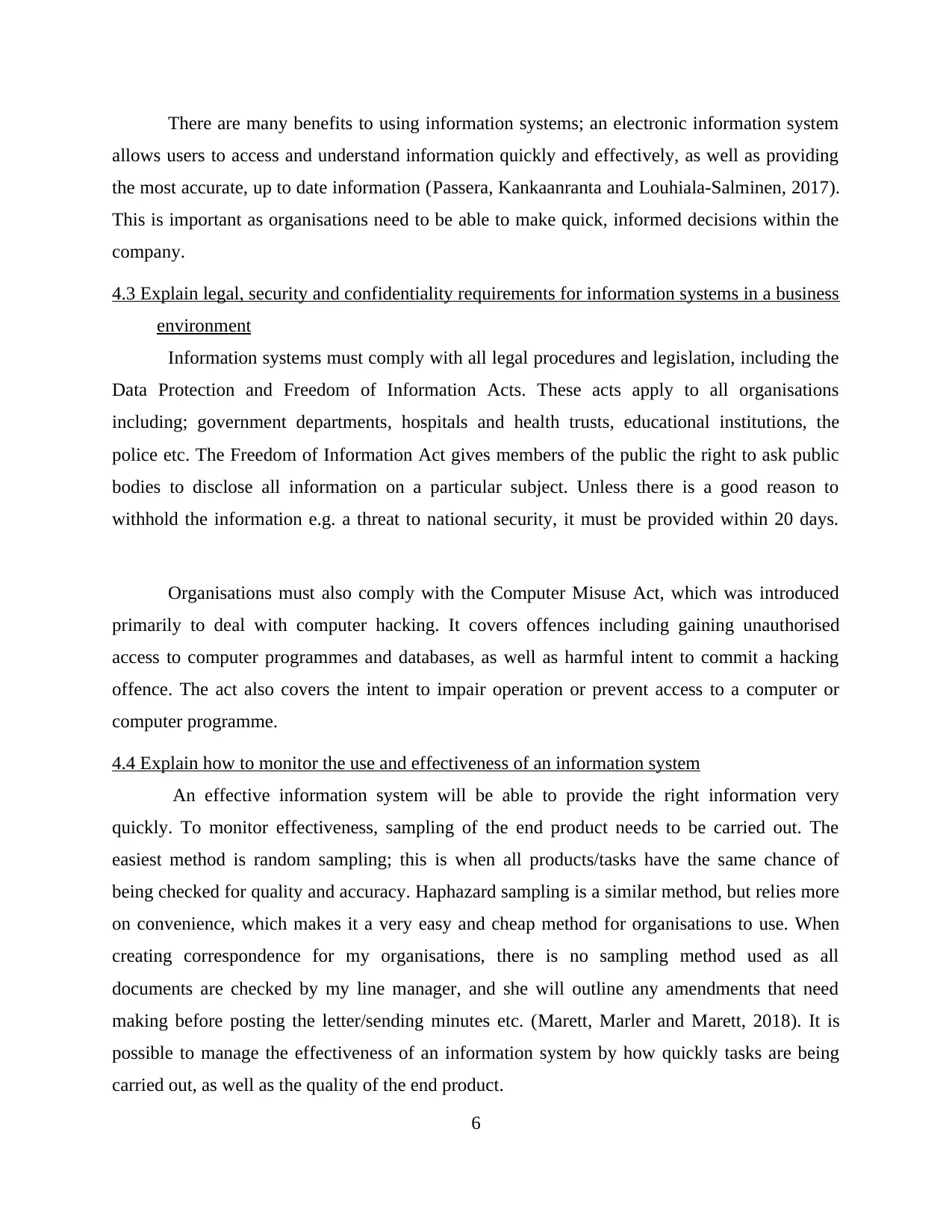
There are many benefits to using information systems; an electronic information system
allows users to access and understand information quickly and effectively, as well as providing
the most accurate, up to date information (Passera, Kankaanranta and Louhiala-Salminen, 2017).
This is important as organisations need to be able to make quick, informed decisions within the
company.
4.3 Explain legal, security and confidentiality requirements for information systems in a business
environment
Information systems must comply with all legal procedures and legislation, including the
Data Protection and Freedom of Information Acts. These acts apply to all organisations
including; government departments, hospitals and health trusts, educational institutions, the
police etc. The Freedom of Information Act gives members of the public the right to ask public
bodies to disclose all information on a particular subject. Unless there is a good reason to
withhold the information e.g. a threat to national security, it must be provided within 20 days.
Organisations must also comply with the Computer Misuse Act, which was introduced
primarily to deal with computer hacking. It covers offences including gaining unauthorised
access to computer programmes and databases, as well as harmful intent to commit a hacking
offence. The act also covers the intent to impair operation or prevent access to a computer or
computer programme.
4.4 Explain how to monitor the use and effectiveness of an information system
An effective information system will be able to provide the right information very
quickly. To monitor effectiveness, sampling of the end product needs to be carried out. The
easiest method is random sampling; this is when all products/tasks have the same chance of
being checked for quality and accuracy. Haphazard sampling is a similar method, but relies more
on convenience, which makes it a very easy and cheap method for organisations to use. When
creating correspondence for my organisations, there is no sampling method used as all
documents are checked by my line manager, and she will outline any amendments that need
making before posting the letter/sending minutes etc. (Marett, Marler and Marett, 2018). It is
possible to manage the effectiveness of an information system by how quickly tasks are being
carried out, as well as the quality of the end product.
6
allows users to access and understand information quickly and effectively, as well as providing
the most accurate, up to date information (Passera, Kankaanranta and Louhiala-Salminen, 2017).
This is important as organisations need to be able to make quick, informed decisions within the
company.
4.3 Explain legal, security and confidentiality requirements for information systems in a business
environment
Information systems must comply with all legal procedures and legislation, including the
Data Protection and Freedom of Information Acts. These acts apply to all organisations
including; government departments, hospitals and health trusts, educational institutions, the
police etc. The Freedom of Information Act gives members of the public the right to ask public
bodies to disclose all information on a particular subject. Unless there is a good reason to
withhold the information e.g. a threat to national security, it must be provided within 20 days.
Organisations must also comply with the Computer Misuse Act, which was introduced
primarily to deal with computer hacking. It covers offences including gaining unauthorised
access to computer programmes and databases, as well as harmful intent to commit a hacking
offence. The act also covers the intent to impair operation or prevent access to a computer or
computer programme.
4.4 Explain how to monitor the use and effectiveness of an information system
An effective information system will be able to provide the right information very
quickly. To monitor effectiveness, sampling of the end product needs to be carried out. The
easiest method is random sampling; this is when all products/tasks have the same chance of
being checked for quality and accuracy. Haphazard sampling is a similar method, but relies more
on convenience, which makes it a very easy and cheap method for organisations to use. When
creating correspondence for my organisations, there is no sampling method used as all
documents are checked by my line manager, and she will outline any amendments that need
making before posting the letter/sending minutes etc. (Marett, Marler and Marett, 2018). It is
possible to manage the effectiveness of an information system by how quickly tasks are being
carried out, as well as the quality of the end product.
6
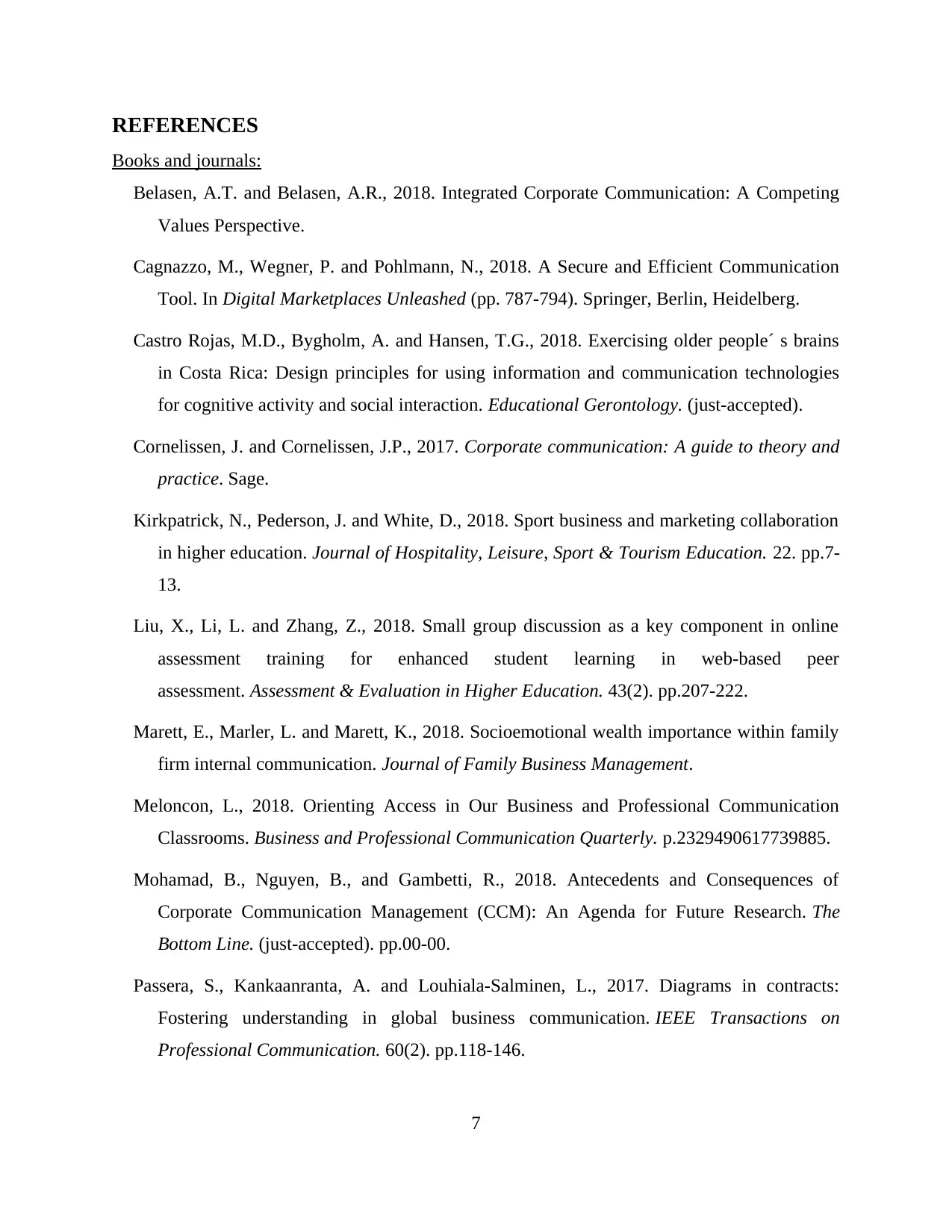
REFERENCES
Books and journals:
Belasen, A.T. and Belasen, A.R., 2018. Integrated Corporate Communication: A Competing
Values Perspective.
Cagnazzo, M., Wegner, P. and Pohlmann, N., 2018. A Secure and Efficient Communication
Tool. In Digital Marketplaces Unleashed (pp. 787-794). Springer, Berlin, Heidelberg.
Castro Rojas, M.D., Bygholm, A. and Hansen, T.G., 2018. Exercising older people´ s brains
in Costa Rica: Design principles for using information and communication technologies
for cognitive activity and social interaction. Educational Gerontology. (just-accepted).
Cornelissen, J. and Cornelissen, J.P., 2017. Corporate communication: A guide to theory and
practice. Sage.
Kirkpatrick, N., Pederson, J. and White, D., 2018. Sport business and marketing collaboration
in higher education. Journal of Hospitality, Leisure, Sport & Tourism Education. 22. pp.7-
13.
Liu, X., Li, L. and Zhang, Z., 2018. Small group discussion as a key component in online
assessment training for enhanced student learning in web-based peer
assessment. Assessment & Evaluation in Higher Education. 43(2). pp.207-222.
Marett, E., Marler, L. and Marett, K., 2018. Socioemotional wealth importance within family
firm internal communication. Journal of Family Business Management.
Meloncon, L., 2018. Orienting Access in Our Business and Professional Communication
Classrooms. Business and Professional Communication Quarterly. p.2329490617739885.
Mohamad, B., Nguyen, B., and Gambetti, R., 2018. Antecedents and Consequences of
Corporate Communication Management (CCM): An Agenda for Future Research. The
Bottom Line. (just-accepted). pp.00-00.
Passera, S., Kankaanranta, A. and Louhiala-Salminen, L., 2017. Diagrams in contracts:
Fostering understanding in global business communication. IEEE Transactions on
Professional Communication. 60(2). pp.118-146.
7
Books and journals:
Belasen, A.T. and Belasen, A.R., 2018. Integrated Corporate Communication: A Competing
Values Perspective.
Cagnazzo, M., Wegner, P. and Pohlmann, N., 2018. A Secure and Efficient Communication
Tool. In Digital Marketplaces Unleashed (pp. 787-794). Springer, Berlin, Heidelberg.
Castro Rojas, M.D., Bygholm, A. and Hansen, T.G., 2018. Exercising older people´ s brains
in Costa Rica: Design principles for using information and communication technologies
for cognitive activity and social interaction. Educational Gerontology. (just-accepted).
Cornelissen, J. and Cornelissen, J.P., 2017. Corporate communication: A guide to theory and
practice. Sage.
Kirkpatrick, N., Pederson, J. and White, D., 2018. Sport business and marketing collaboration
in higher education. Journal of Hospitality, Leisure, Sport & Tourism Education. 22. pp.7-
13.
Liu, X., Li, L. and Zhang, Z., 2018. Small group discussion as a key component in online
assessment training for enhanced student learning in web-based peer
assessment. Assessment & Evaluation in Higher Education. 43(2). pp.207-222.
Marett, E., Marler, L. and Marett, K., 2018. Socioemotional wealth importance within family
firm internal communication. Journal of Family Business Management.
Meloncon, L., 2018. Orienting Access in Our Business and Professional Communication
Classrooms. Business and Professional Communication Quarterly. p.2329490617739885.
Mohamad, B., Nguyen, B., and Gambetti, R., 2018. Antecedents and Consequences of
Corporate Communication Management (CCM): An Agenda for Future Research. The
Bottom Line. (just-accepted). pp.00-00.
Passera, S., Kankaanranta, A. and Louhiala-Salminen, L., 2017. Diagrams in contracts:
Fostering understanding in global business communication. IEEE Transactions on
Professional Communication. 60(2). pp.118-146.
7
⊘ This is a preview!⊘
Do you want full access?
Subscribe today to unlock all pages.

Trusted by 1+ million students worldwide
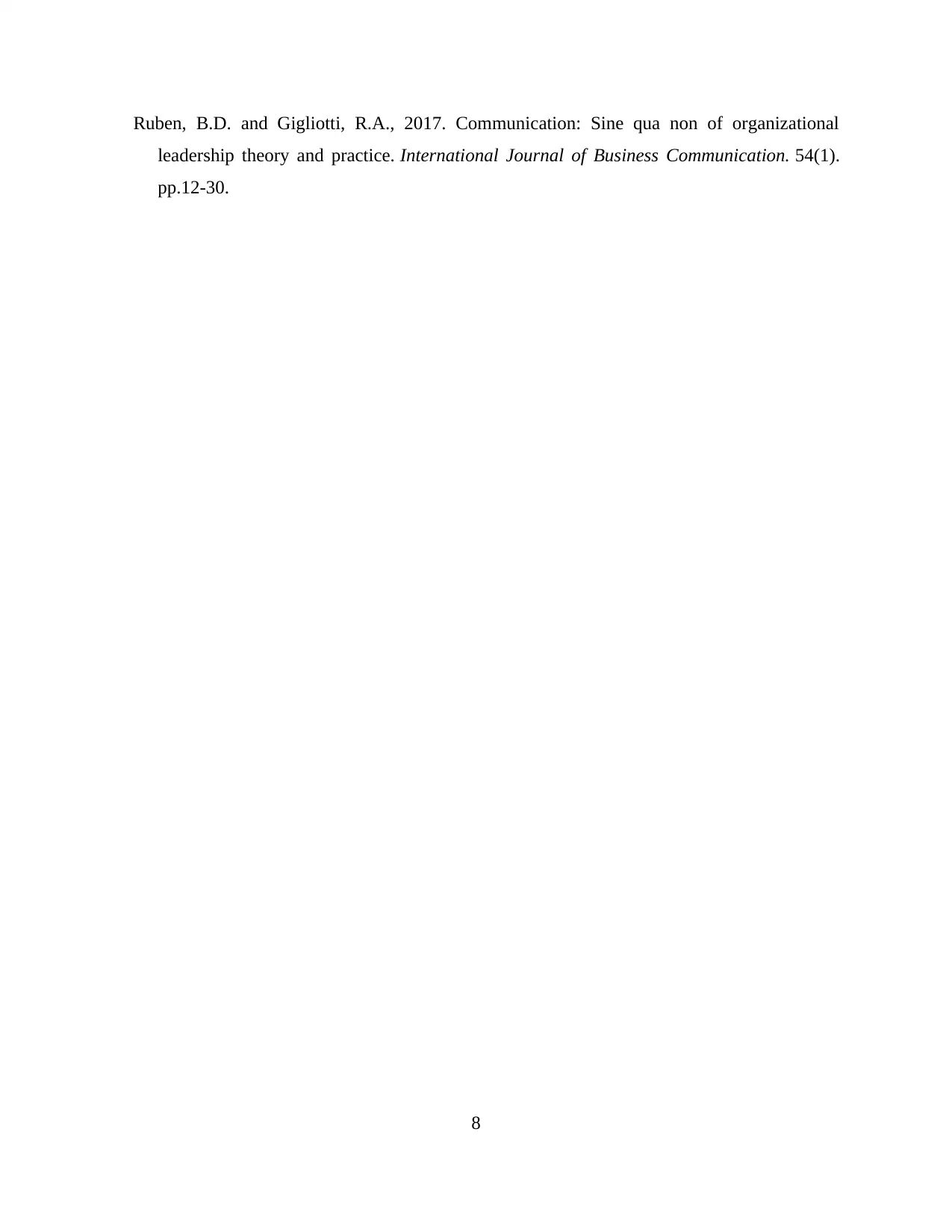
Ruben, B.D. and Gigliotti, R.A., 2017. Communication: Sine qua non of organizational
leadership theory and practice. International Journal of Business Communication. 54(1).
pp.12-30.
8
leadership theory and practice. International Journal of Business Communication. 54(1).
pp.12-30.
8
1 out of 10
Related Documents
Your All-in-One AI-Powered Toolkit for Academic Success.
+13062052269
info@desklib.com
Available 24*7 on WhatsApp / Email
![[object Object]](/_next/static/media/star-bottom.7253800d.svg)
Unlock your academic potential
Copyright © 2020–2025 A2Z Services. All Rights Reserved. Developed and managed by ZUCOL.





